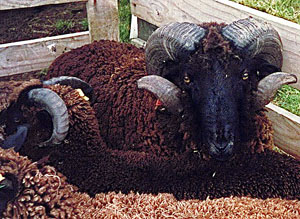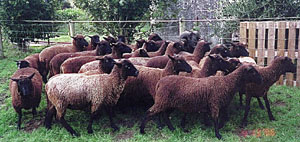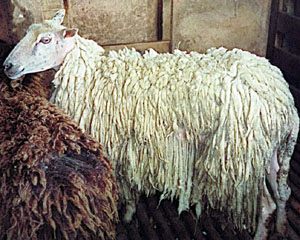Pitt Island Sheep
 The islands of the Chatham group lie around longitude 176°W and latitude 44°S, about
750 km east of the mainland of New Zealand. Pitt Island is 16 by 10 km and 6500 ha.
It is inhabited by about 50 people. Saxony merino sheep were introduced to Pitt Island
around 1841. They have been untended for about 80 years. Natural selection has been
operating and selecting for those sheep with self-shedding fleeces and with natural
parasite resistance. Originally they were all white. In the 1940s, a black sheep was
a novelty. Half were black by 1960 and now in 1997 90% of the flock is pigmented,
most of those being solid black and around 5% moorit. The mean shoulder height of
the males is 766 mm, body length 1240 mm; females shoulder height 695 mm, body length
1262 mm. On Pitt Island 96.8% of rams have horns and the remainder are polled or (very
rarely) have scurs. Most Pitt Island ewes however, have scurs (53.6%); of the rest,
32,4% were polled and 12.8% had horns. The horns can be massive forming complete spirals
up to 95 cm around the curve.
The islands of the Chatham group lie around longitude 176°W and latitude 44°S, about
750 km east of the mainland of New Zealand. Pitt Island is 16 by 10 km and 6500 ha.
It is inhabited by about 50 people. Saxony merino sheep were introduced to Pitt Island
around 1841. They have been untended for about 80 years. Natural selection has been
operating and selecting for those sheep with self-shedding fleeces and with natural
parasite resistance. Originally they were all white. In the 1940s, a black sheep was
a novelty. Half were black by 1960 and now in 1997 90% of the flock is pigmented,
most of those being solid black and around 5% moorit. The mean shoulder height of
the males is 766 mm, body length 1240 mm; females shoulder height 695 mm, body length
1262 mm. On Pitt Island 96.8% of rams have horns and the remainder are polled or (very
rarely) have scurs. Most Pitt Island ewes however, have scurs (53.6%); of the rest,
32,4% were polled and 12.8% had horns. The horns can be massive forming complete spirals
up to 95 cm around the curve.
 In April 1981, 305 of these feral sheep were placed in a specially created scientific
reserve on Pitt Island and the other sheep outside the reserve are being exterminated.
Some have been exported to the mainland of New Zealand where they are maintained by
rare breeds enthusiasts.
In April 1981, 305 of these feral sheep were placed in a specially created scientific
reserve on Pitt Island and the other sheep outside the reserve are being exterminated.
Some have been exported to the mainland of New Zealand where they are maintained by
rare breeds enthusiasts.
The white ewe shows the appearance of the feral animals on Pitt Island. The group image is indicative of the appearance of the shorn animals after being moved to good management practices for one year. Some rams have horns with a much looser spiral than illustrated in the top photograph. Some also have horns that sweep back and then downwards but never curl upwards again.
 Fleece weight and staple length (± standard deviation)
Fleece weight and staple length (± standard deviation)
- Growth period: 1 year
- Greasy fleece weight mean (kg): 2.0 ± 0.5
- Greasy fleece range (kg): 1.5 - 2.8
- Staple length mean (cm): 7.3 ± 1.6
Diameters (95% confidence interval in parentheses) of wool fibers.
- Mode (mm): 24.3 (1.7)
- Median (mm): 24.1 (1.3)
- Mean (mm): 24.4 (1.0)
- Coefficient of variation (%): 17.3 (1.5)
- Range (mm): 11 - 47
- Skewness (normal = 0): 0.3 (0.3)
- Kurtosis (normal = 3): 3.1 (1.2)
Characteristics of wool follicle and fleece. (*, 95% confidence interval; sample sizes in parentheses)
- S/P ratio: 4.9 0.6* (10)
- Follicle density (mm-2): 19.1 4.0* (10)
- Follicle depth (mm): 1232 79* (11)
- Bulk (cm3 g-1) mean: 32.6 1.8* (4)
- Bulk (cm3 g-1) range: 31.7 - 34.3 (4)
- Yield (%): 2 45.7 6.2* (11)
References
Arthur Bennett, New Zealand, herne@clear.net.nz
Mason, I.L. 1996. A World Dictionary of Livestock Breeds, Types and Varieties. Fourth Edition. C.A.B International. 273 pp.
